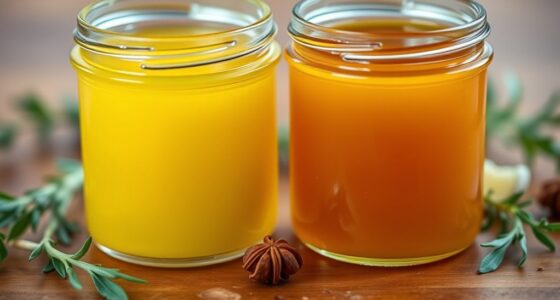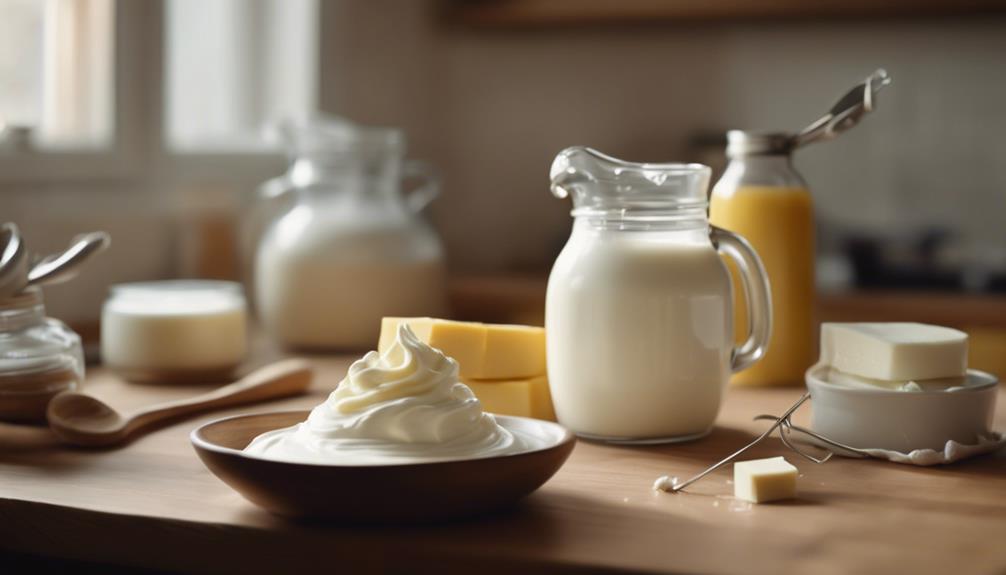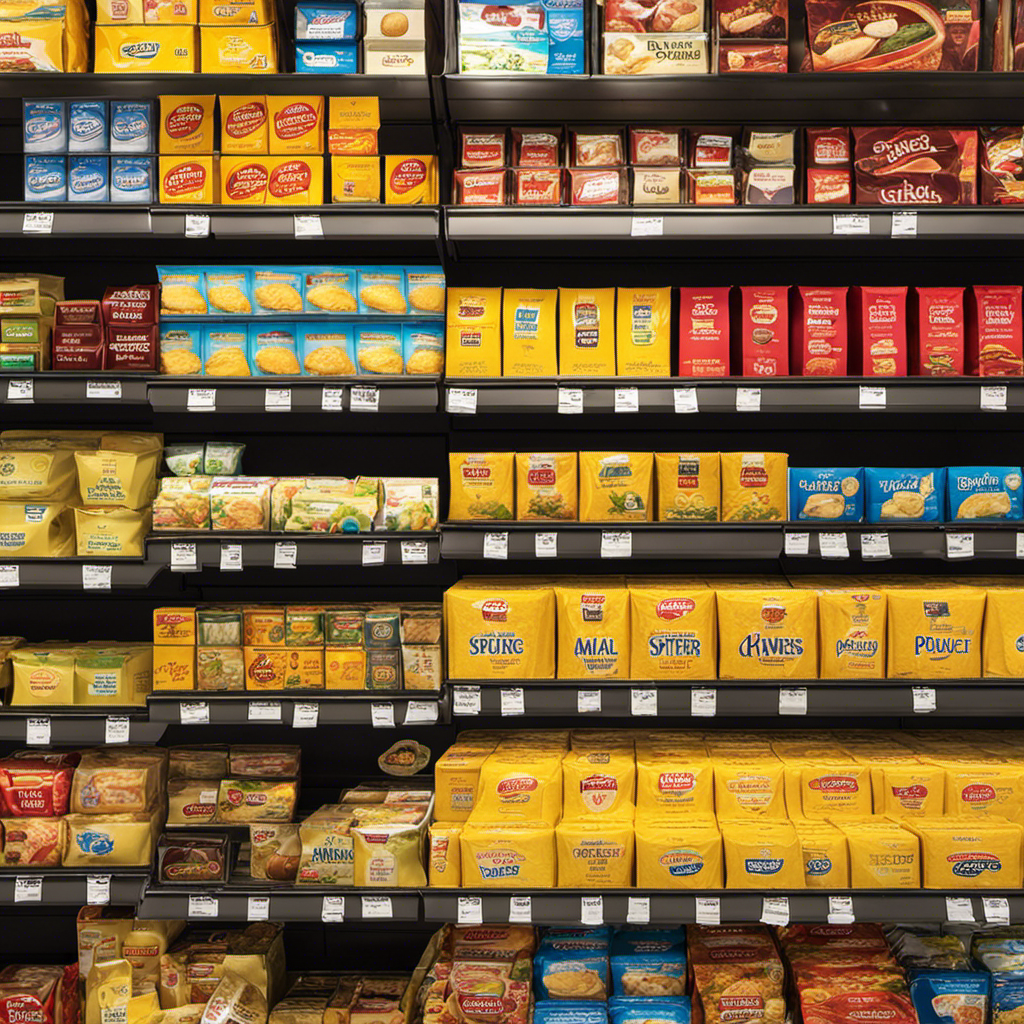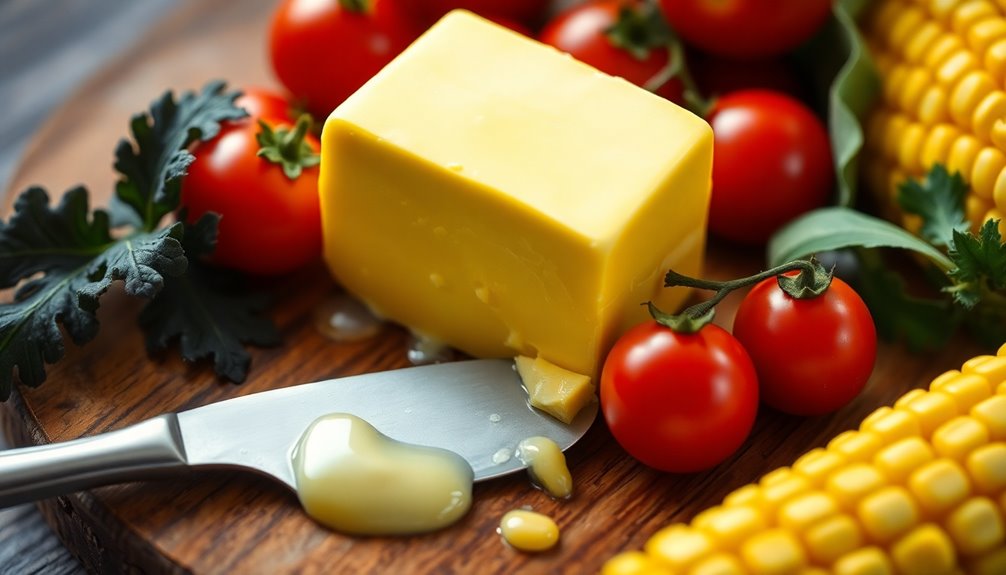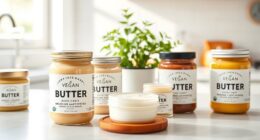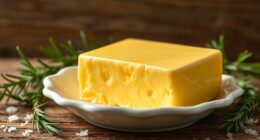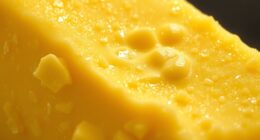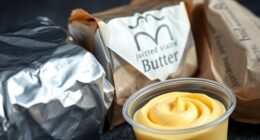If you’re a fan of all things apple, you may have wondered about how long apple butter lasts. Well, wonder no more! In this article, we will explore what factors affect the shelf life of apple butter and find out the best ways to store it properly.
From refrigeration to freezing, we’ll cover it all. So, grab a spoon and get ready to savor the sweet and tangy goodness of apple butter, knowing just how long it will last.
Let’s dig in!
Key Takeaways
- Quality of ingredients, such as the apples used and the amount of sugar added, can affect the shelf life of apple butter.
- Proper cooking techniques, including the temperature and time used, can enhance the flavor and longevity of apple butter.
- Choosing the right storage conditions, such as using glass jars with airtight lids and storing in a cool, dark place, can help extend the shelf life of apple butter.
- Refrigerating or freezing apple butter can significantly extend its shelf life, with freezing allowing for storage of up to two years.
Factors Affecting Apple Butter Shelf Life
There are several factors that can affect how long apple butter lasts. The taste of apple butter can be influenced by factors such as the quality of the apples used, the amount of sugar added, and the cooking process. Using ripe, flavorful apples will result in a more delicious apple butter. Additionally, the amount of sugar added can affect the sweetness and overall taste of the butter. Cooking the apple butter at the right temperature and for the right amount of time is also crucial in preserving its freshness. Properly cooked apple butter will have a smooth and creamy texture, enhancing its flavor and longevity.
Understanding these factors is important in ensuring that your apple butter remains fresh and tasty for as long as possible.
To continue preserving the freshness of apple butter, proper storage is essential.
Proper Storage of Apple Butter
When it comes to the shelf life of apple butter, it is important to consider the best storage conditions.
As someone who loves apple butter, I have done my fair share of research on how to keep it fresh and tasty for as long as possible.
In this discussion, we will explore the factors that affect the shelf life of apple butter and the best storage conditions to ensure its longevity.
Shelf Life of Apple Butter
To determine the shelf life of apple butter, you should check the expiration date listed on the jar. However, there are several factors that can affect the spoilage of homemade apple butter.
One important factor is the quality and freshness of the ingredients used. Using ripe and unblemished apples, along with the right amount of sugar and spices, can help preserve the apple butter for a longer period of time.
Additionally, proper sterilization of the jars and lids before canning is crucial in preventing bacterial growth and spoilage. Storing the apple butter in a cool, dark place, such as a pantry or cellar, can also extend its shelf life.
It is important to note that homemade apple butter usually has a shelf life of about 1 year, but it is always best to check the expiration date to be sure.
Best Storage Conditions
The best conditions for storing homemade apple butter include keeping it in a cool, dark place like a pantry or cellar. To preserve its freshness, it’s important to choose the best container for storing apple butter. I recommend using glass jars with airtight lids.
Glass containers are ideal because they are non-reactive and won’t absorb any odors or flavors from the apple butter. Additionally, the airtight lids will prevent any air from entering the container, which can lead to spoilage.
When filling the jars, make sure to leave about half an inch of headspace to accommodate for expansion during freezing. Once the apple butter is in the jars, seal them tightly and store them in a cool, dark place. This will ensure that your homemade apple butter stays fresh and delicious for a long time.
Speaking of storage, if you find yourself with an abundance of apple butter or if you prefer a longer shelf life, refrigerating apple butter is another option to consider.
Refrigerating Apple Butter
When it comes to storing apple butter, it’s important to consider its shelf life without refrigeration and the optimal storage temperature.
Without refrigeration, apple butter can last for several months if stored properly in a cool, dry place.
However, to maintain its quality and freshness for a longer period, it’s recommended to store apple butter in the refrigerator at a temperature of around 40°F (4°C).
Shelf Life Without Refrigeration
If you don’t refrigerate apple butter, it can last for several months. The shelf stability of apple butter without refrigeration depends on the preserving methods used.
Apple butter is made by cooking apples with sugar and spices until thick and smooth. To increase shelf stability, some people choose to can their apple butter through a process called water bath canning. This involves sealing the apple butter in sterile jars and boiling them to create a vacuum seal. This method can extend the shelf life of apple butter up to a year or more.
Another preserving method is freezing. By storing apple butter in airtight containers in the freezer, it can last for up to two years. However, it’s important to note that the texture and flavor of apple butter may change slightly after extended periods of storage.
When it comes to optimal storage temperature, refrigeration is recommended to maintain the freshness and quality of apple butter.
Optimal Storage Temperature
Refrigeration is recommended for maintaining the freshness and quality of apple butter. The effects of temperature on apple butter shelf life are significant. To extend its shelf life, it is best to store apple butter in the refrigerator at temperatures below 40 degrees Fahrenheit. This helps slow down the growth of bacteria and other microorganisms that can cause spoilage.
Keeping apple butter in a cool, dark place can also help preserve its quality. It is important to avoid exposing it to direct sunlight or heat sources, as this can accelerate spoilage and affect its taste and texture.
Freezing Apple Butter
To freeze apple butter, you can place it in airtight containers or freezer bags. Freezing apple butter is a great way to extend its shelf life and ensure that you can enjoy it for longer. When freezing apple butter, make sure to leave some headspace in the containers or bags to allow for expansion during freezing.
Label the containers or bags with the date of freezing to keep track of its freshness. To use frozen apple butter, simply thaw it in the refrigerator overnight or at room temperature for a few hours. Once thawed, give it a good stir to restore its smooth consistency.
Frozen apple butter can be used in various ways. For example, you can spread it on toast, add it to oatmeal or yogurt, or use it as a filling for pastries.
Room Temperature Storage of Apple Butter
When storing apple butter at room temperature, you’ll want to keep it in a cool, dry place away from direct sunlight. This will help preserve its flavor and extend its shelf life.
To ensure the best storage conditions, use airtight storage containers that are made of glass or food-grade plastic. These containers will prevent air and moisture from entering, which can cause the apple butter to spoil.
It’s important to note that room temperature storage is suitable for short-term use, typically up to a few weeks. If you plan on storing apple butter for longer periods, it’s recommended to refrigerate or freeze it.
Remember to label your storage containers with the date of preparation to keep track of freshness.
Signs of Spoiled Apple Butter
If you notice any changes in color, texture, or smell, it’s a sign that your apple butter may have spoiled. Spoiled apple butter can be unsafe to consume and should be discarded. To help you identify whether your apple butter has gone bad, here are some common signs to look out for:
| Signs of Spoiled Apple Butter |
|---|
| Mold or fuzziness on the surface |
| Off or rancid smell |
| Unusual color or texture |
| Sour or fermented taste |
If you come across any of these indicators, it’s best to err on the side of caution and not use the expired apple butter. Using spoiled apple butter can lead to foodborne illnesses and ruin the taste of your dishes. To ensure the longevity of your apple butter, it’s important to follow proper storage guidelines and take necessary precautions.
Extending the Shelf Life of Apple Butter
When it comes to apple butter, I understand the importance of extending its shelf life and preserving its freshness.
There are a few methods you can try to achieve this.
First, make sure to store your apple butter in airtight containers. This will prevent any air from getting in and causing spoilage.
Additionally, keep your apple butter in a cool, dark place, such as a pantry or cellar. Exposure to heat and light can accelerate the deterioration process.
If you’re looking for an even longer shelf life, consider freezing your apple butter in freezer-safe containers. This will keep it fresh for up to a year. Just remember to thaw it in the refrigerator before using.
Best Practices for Preserving Apple Butter
To preserve your apple butter, keep it in airtight containers and store them in a cool, dark place. This will help prolong its freshness and prevent spoilage.
Airtight containers create a barrier against air and moisture, which can cause the apple butter to spoil faster. Storing it in a cool, dark place, such as a pantry or cellar, helps maintain its quality by protecting it from heat and sunlight.
Avoid placing the apple butter near any heat sources or in direct sunlight, as this can accelerate its deterioration.
By following these best practices, you can ensure that your apple butter stays fresh for a longer period of time and maintains its delicious flavor.
Now let’s explore how to use apple butter before it expires.
Using Apple Butter Before It Expires
Now that we know how to properly preserve apple butter, let’s talk about how to make the most of it before it expires. Apple butter is incredibly versatile and can be used in a variety of recipes to add a sweet and tangy flavor. Whether you spread it on toast, swirl it into oatmeal, or use it as a filling for pastries, apple butter adds a delicious touch to any dish.
But it’s not just about the taste, apple butter also offers a range of health benefits. It is packed with vitamins and minerals, such as vitamin C and potassium, and is a good source of dietary fiber. Additionally, apple butter is low in fat and cholesterol-free, making it a healthier alternative to other spreads and toppings.
So go ahead and get creative with your apple butter! Experiment with different recipes and enjoy the added flavor and nutritional benefits it brings to your meals.
Now, let’s move on to the next topic: storing homemade apple butter.
Storing Homemade Apple Butter
After making a batch of homemade apple butter, it’s important to store it properly to maintain its freshness. One of the best ways to store apple butter is in glass jars with tight-fitting lids. Make sure the jars are clean and dry before filling them with the apple butter. It’s also a good idea to label the jars with the date of preparation.
Store the jars in a cool, dark place like a pantry or cupboard. Apple butter can last for several months when stored properly.
In terms of the health benefits of apple butter, it is a good source of dietary fiber and contains vitamins and minerals such as vitamin C and potassium. It can also be enjoyed in a variety of ways, such as spread on toast or used as a topping for pancakes or yogurt.
Apple Butter Expiration Dates
Apple butter can stay fresh for several months when stored properly in glass jars with tight-fitting lids. It is a delicious spread made from cooked apples, sugar, and spices. There are many apple butter recipes available, allowing you to customize the flavors to your liking. Not only is apple butter a tasty addition to toast and biscuits, but it also has health benefits. Apples are packed with essential vitamins and antioxidants, which can improve digestion, boost immunity, and promote heart health. The cooking process of apple butter helps to concentrate these nutrients, making it a nutritious and flavorful choice. By incorporating apple butter into your diet, you can enjoy both its delicious taste and the numerous health benefits it provides.
| Apple Butter Recipes | Health Benefits of Apple Butter |
|---|---|
| Cinnamon-Apple Butter | High in vitamins and antioxidants |
| Ginger-Spiced Apple Butter | Boosts immunity and digestion |
| Maple-Infused Apple Butter | Promotes heart health |
| Spicy Jalapeno Apple Butter | Provides anti-inflammatory properties |
| Pumpkin-Spiced Apple Butter | Enhances skin health and appearance |
Frequently Asked Questions
Can Apple Butter Be Stored at Room Temperature for an Extended Period of Time?
Yes, you can store apple butter at room temperature for an extended period of time. However, it is important to note that the shelf life of apple butter can vary, so it’s best to check the expiration date or recommended storage guidelines.
Are There Any Special Precautions I Need to Take When Storing Homemade Apple Butter?
When storing homemade apple butter, it’s important to take special precautions. Ensure it is stored in airtight containers, in a cool and dark place. Regularly check for signs of spoilage to keep it safe to eat.
How Can I Tell if Apple Butter Has Gone Bad or Spoiled?
If apple butter has spoiled, signs of spoilage include mold, an off smell, or a strange texture. To extend its shelf life, apple butter can be refrigerated, which can help it stay fresh for a longer period.
Can I Freeze Apple Butter to Extend Its Shelf Life?
Freezing apple butter is a great way to extend its shelf life. I always freeze mine in small portions, so I can defrost one at a time. It’s a handy alternative to keep enjoying that delicious spread!
What Are the Best Practices for Preserving Apple Butter to Ensure It Lasts as Long as Possible?
Preserving homemade apple butter involves proper storage techniques. After making apple butter, allow it to cool completely before transferring it to clean, airtight jars. Store in a cool, dark place for optimal shelf life.
Conclusion
In conclusion, it is important to properly store apple butter to ensure its shelf life. By refrigerating or freezing apple butter, you can extend its freshness for several months. However, if left at room temperature, it may only last a few weeks.
To make the most out of your apple butter, be sure to use it before it expires. For example, my friend Sarah made a batch of homemade apple butter and stored it in the refrigerator. She used it to make delicious apple butter muffins, which were a hit at our weekend brunch.
So remember, store your apple butter correctly and enjoy its delectable flavors for longer!


